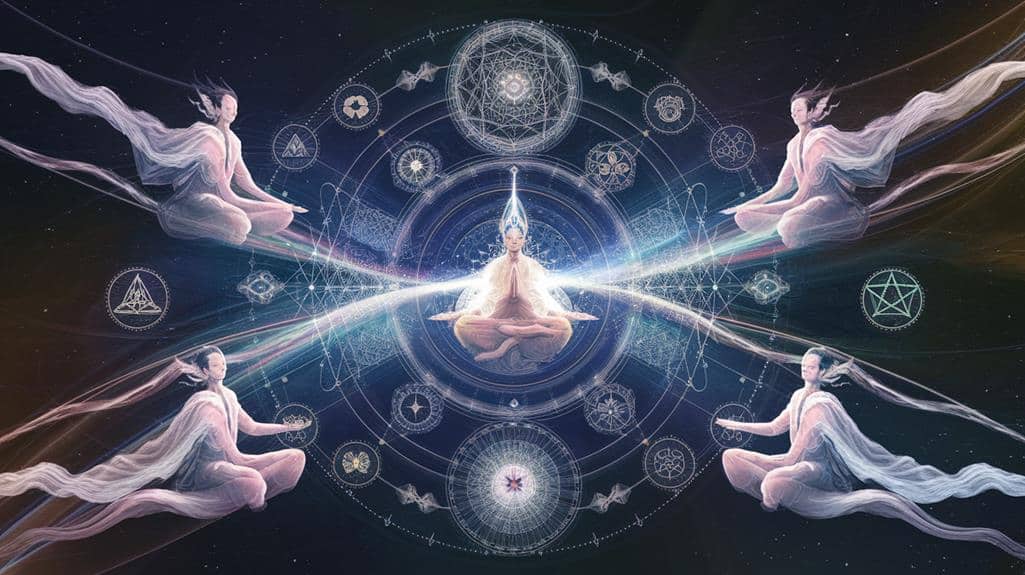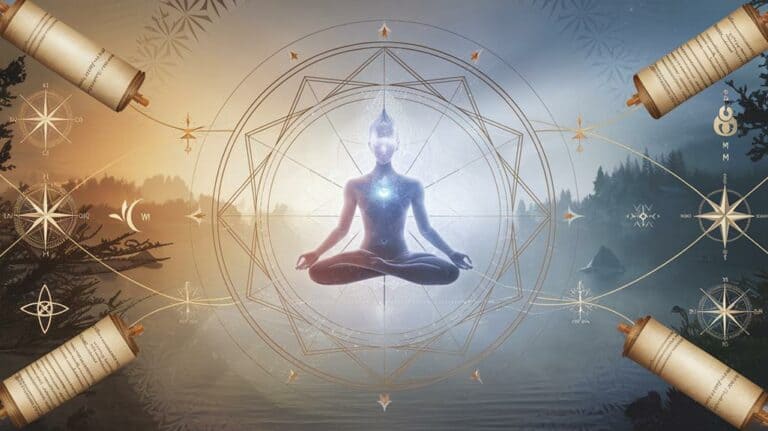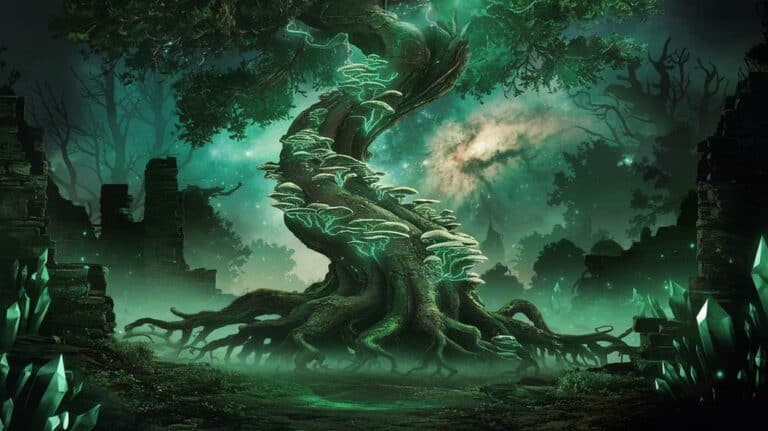Comparative Mysticism Across Different Religions and Cultures
When you explore the mystical traditions across world religions, you’ll discover an intriguing paradox: while mystics use vastly different practices and languages to describe their experiences, they often arrive at remarkably similar insights. Whether it’s a Buddhist monk in deep meditation, a Sufi whirling in ecstatic dance, or a Native American elder on a vision quest, these seekers report encounters with ineffable truth that transcends ordinary consciousness. You’ll find that despite cultural and theological differences, mystical experiences share common elements—a dissolution of ego, a sense of unity with the divine, and transformative insights that challenge our conventional understanding of reality.
Core Elements of Mystical Experience
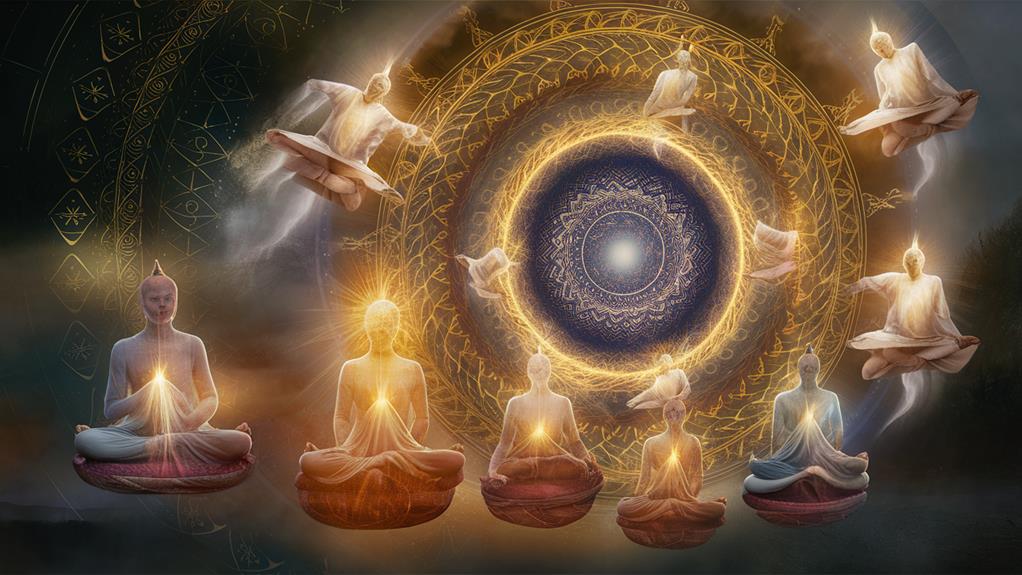
Throughout history and across cultures, mystical experiences share several fundamental characteristics that transcend religious boundaries.
When you’re immersed in a mystical state, you’ll find yourself encountering what mystics describe as the “ineffable” – an experience so profound that words fail to capture its essence.
You’ll discover that time and space seem to dissolve, leaving you with a profound sense of unity with something far greater than yourself.
In these transcendent moments, you’ll likely experience what’s known as the “noetic quality,” where you’re granted insights that feel absolutely true and real, even if they defy logical explanation.
You’ll notice that dualities dissolve – the boundary between subject and object blurs, and you’ll sense a deep interconnectedness with all of existence.
The ego, that persistent sense of “I,” temporarily falls away, replaced by a vast awareness that mystics call “cosmic consciousness.”
These core elements – ineffability, transcendence of space and time, noetic quality, unity, and ego dissolution – emerge consistently whether you’re studying the experiences of Sufi saints, Buddhist monks, Christian contemplatives, or indigenous shamans.
Buddhist and Hindu Mystical Practices
These core elements of mystical experience find powerful expression in Eastern spiritual traditions, particularly in Buddhist and Hindu practices that have evolved over thousands of years.
You’ll discover that Buddhist meditation techniques like vipassana and samatha guide you toward direct insight into the nature of consciousness, while Hindu yoga traditions offer pathways to union with the divine through practices like pranayama and dhyana.
In Buddhism, you’re invited to explore the emptiness of phenomena through mindful observation, letting go of attachments until you’ve dissolved the boundaries between subject and object.
The practice of zazen, especially, teaches you to sit with whatever arises, neither grasping nor rejecting.
Hindu traditions, meanwhile, lead you through the layers of existence – from gross to subtle – using mantras, visualization, and energy work to awaken kundalini and reveal your true nature as Atman.
You’ll find that both traditions emphasize the importance of a qualified teacher who’s walked the path before you, someone who can guide you through the challenges and confirmations of your mystical journey while helping you avoid the common pitfalls of spiritual bypassing.
Western Esoteric Traditions
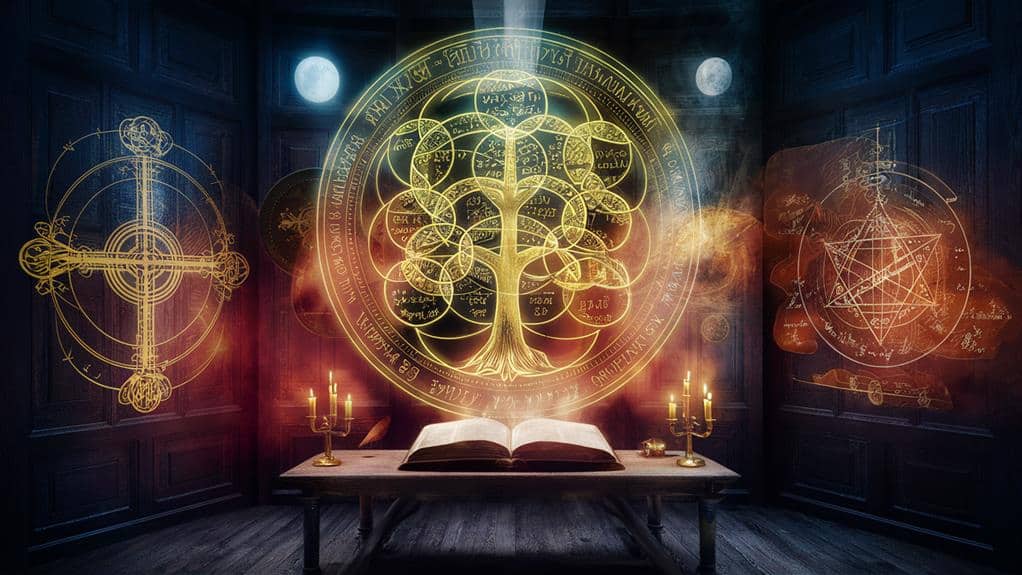
Western esoteric traditions explore mystical practices that emerged from Hermetic, Kabbalistic, and Gnostic teachings. You’ll find these paths interweaving ancient wisdom with practical techniques for spiritual transformation, offering a uniquely Western approach to mystical enlightenment.
Through ritualized ceremonies, meditation, and the study of sacred symbols, you’re invited to reveal the hidden dimensions of consciousness that lie beyond ordinary perception.
Within these traditions, you’ll discover the Art of Alchemy, which isn’t merely about transforming base metals into gold, but rather speaks to your own spiritual metamorphosis. The Hermetic axiom “as above, so below” reveals how macrocosmic truths reflect in your personal microcosm.
You’re encouraged to explore the Tree of Life in Kabbalah, which maps the journey from divine unity to material manifestation, while Gnostic teachings illuminate the path to direct spiritual knowledge.
These Western paths don’t require you to abandon your cultural roots to achieve mystical insights. Instead, they offer a framework that’s deeply embedded in Western philosophical thought, allowing you to explore transcendent states while maintaining your connection to European spiritual heritage.
Indigenous Spiritual Wisdom
Across diverse cultures and landscapes, indigenous spiritual wisdom embodies a profound connection to the natural world and ancestral knowledge.
You’ll discover that these ancient traditions don’t separate the sacred from the everyday – they’re interwoven into every aspect of life, from the rising sun to the changing seasons.
When you explore indigenous mysticism, you’ll find that it’s deeply rooted in direct experience rather than abstract theology.
You’re invited to understand how indigenous peoples have maintained unbroken dialogues with the spirit world through ceremonies, vision quests, and sacred rituals that have been preserved across generations.
The wisdom keepers teach that you’re not separate from nature – you’re an integral part of it.
You’ll notice that indigenous spiritual practices often emphasize the circle of life, where everything’s connected in a sacred web of relationships.
Through drumming, dancing, and ceremonial practices, you’re able to access altered states of consciousness that reveal deeper truths about your place in the cosmos.
This wisdom reminds you that authentic spirituality isn’t found in books or institutions, but in your lived experience of connection to the land, community, and the spirit world.
Sufi and Islamic Mysticism
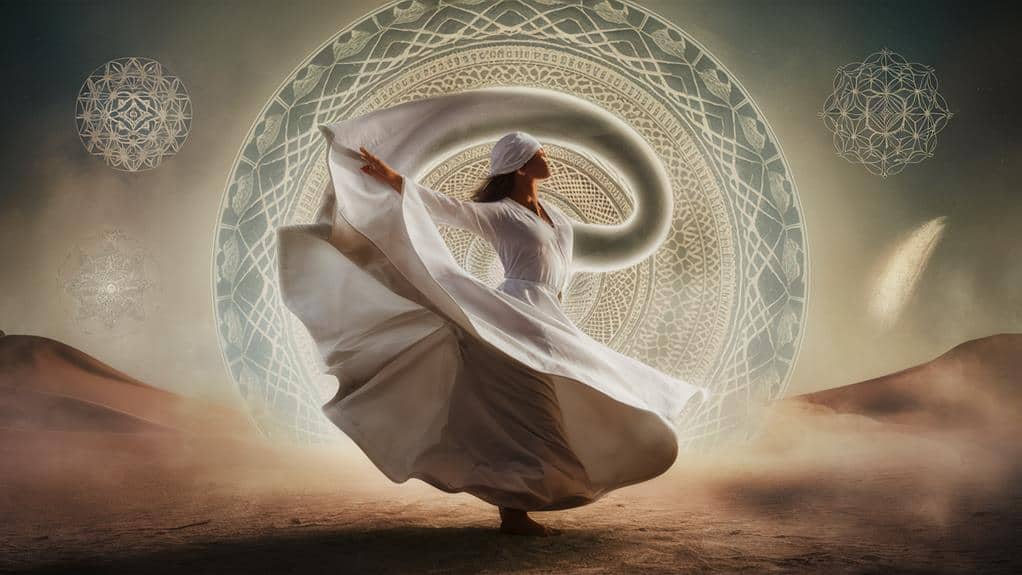
In accordance with Islamic tradition, Sufi mystics seek direct personal experience of the divine through practices like dhikr (remembrance of God), meditation, and ecstatic dance. You’ll find that these mystics don’t simply study religious texts but immerse themselves in transformative spiritual practices that dissolve the boundaries between seeker and sought, connecting directly with divine reality through the heart’s wisdom.
As you explore Sufi mysticism, you’ll discover how these seekers employ poetry, music, and whirling meditation to transcend ordinary consciousness. The legendary poet Rumi’s verses aren’t mere literature – they’re gateways to mystical revelation, inviting you to experience what lies beyond intellectual understanding.
Through practices like sama (spiritual concert), you’re drawn into states of ecstatic union that reveal divine presence in every breath.
You’ll notice how Sufis emphasize the path of love, teaching that it’s through the heart, not just the mind, that you’ll discover ultimate truth. They’ll show you how every aspect of existence can become a mirror reflecting divine beauty, transforming ordinary perception into continuous awareness of sacred presence.
Common Threads Among Mystic Paths
Several key themes unite mystical traditions worldwide, transcending cultural and religious boundaries. You’ll find that mystics across different paths share a fundamental recognition of the illusory nature of the ego and the quest for direct experience of ultimate reality.
Whether you’re exploring Buddhist meditation, Sufi dhikr, or Christian contemplative prayer, you’ll encounter the common thread of transcending ordinary consciousness to achieve union with the divine or absolute.
You’ll notice how mystical traditions consistently emphasize the inadequacy of language to fully capture transcendent experiences, leading to the use of paradox, poetry, and metaphor.
The journey inward that you’ll discover in these paths invariably involves purification of the self, requiring you to release attachments and overcome the limitations of dual perception.
In each tradition, you’ll find experienced guides who’ve walked the path before, teaching that mystical realization isn’t just theoretical knowledge but a transformative experience that’ll reshape your entire being.
These paths share the understanding that you’re already connected to what you seek – you just need to clear away what obscures this truth.
Modern Scientific Perspectives

Modern scientific inquiry into mystical experiences has revealed fascinating neurological correlates that validate many traditional claims. You’ll find that brain imaging studies show distinct patterns of neural activity during meditation and contemplative states, particularly in regions associated with self-awareness and emotional processing.
When you enter deep meditative states, your default mode network – responsible for self-referential thinking – shows reduced activity, matching mystics’ descriptions of ego dissolution.
Research into psychedelics and entheogens has demonstrated that you can reliably induce experiences remarkably similar to those described in mystical traditions, suggesting common neurological pathways to transcendent states.
You’ll discover that whether through meditation, breathwork, or plant medicines, these altered states of consciousness consistently produce measurable changes in brain function and connectivity.
Scientists have identified increased coherence between different brain regions during mystical experiences, supporting the subjective sense of unity and interconnectedness that mystics often report.
This emerging field of neurotheology bridges the gap between ancient wisdom and modern understanding, showing you how your brain’s natural capacity for transcendent experience aligns with centuries-old practices and insights.
Mystical States and Consciousness
While scientific research illuminates the physical basis of mystical experiences, understanding the nature of consciousness itself remains central to comparative mysticism. You’ll find that mystical states often transcend your ordinary waking consciousness, opening doorways to what you might experience as ultimate reality or divine presence.
These states don’t simply alter your perception – they transform your entire way of being in the world. When you enter these heightened states of awareness, you’ll notice how the boundary between subject and object begins to dissolve. Your usual sense of separate selfhood may give way to what mystics describe as unity consciousness, where you’re no longer merely observing reality but becoming one with it.
This isn’t just an intellectual understanding – it’s a direct, lived experience that can permanently reshape your worldview. These states often share common characteristics across cultures: ineffability, where words fail to capture the experience; noetic quality, where profound insights arise; transiency, as they typically don’t last long; and passivity, where you feel carried by something greater than yourself.
You’ll discover that these experiences, while deeply personal, point to universal aspects of human consciousness that transcend cultural boundaries.
Cross-Cultural Mystical Symbols
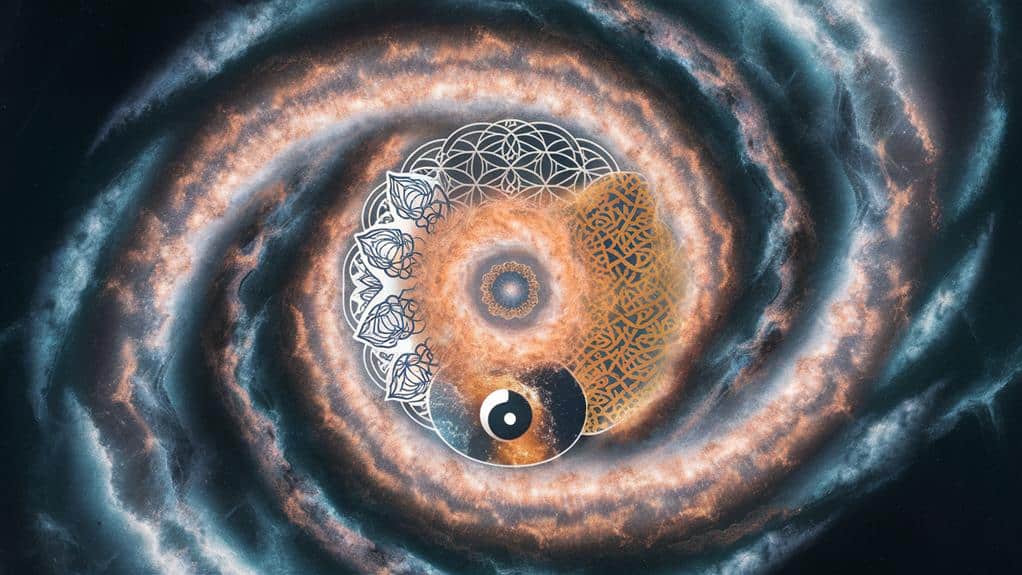
Throughout history’s spiritual traditions, mystical symbols have emerged independently across cultures, often carrying remarkably similar meanings despite vast geographical distances.
You’ll find the spiral appearing in Celtic stone carvings, Native American petroglyphs, and Australian Aboriginal art, representing the eternal cycle of life and spiritual evolution.
The sacred circle manifests as the Buddhist mandala, Hindu yantra, and Native American medicine wheel – each expressing cosmic wholeness and divine unity.
When you explore these cross-cultural symbols more deeply, you’ll discover how the Tree of Life spans Norse mythology, Kabbalah, and ancient Egyptian beliefs, connecting earthly existence to celestial domains.
The serpent, too, winds its way through humanity’s collective spiritual consciousness, embodying transformation in Hindu Kundalini practices and Aztec mythology alike.
As you contemplate these universal symbols, you’ll notice how the sacred mountain appears in traditions from Mount Kailash to Mount Fuji, representing humanity’s ascent toward divine understanding.
These recurring motifs aren’t mere coincidences – they’re expressions of our shared spiritual heritage, speaking to fundamental truths that transcend cultural boundaries and resonate with the deepest layers of human consciousness.



